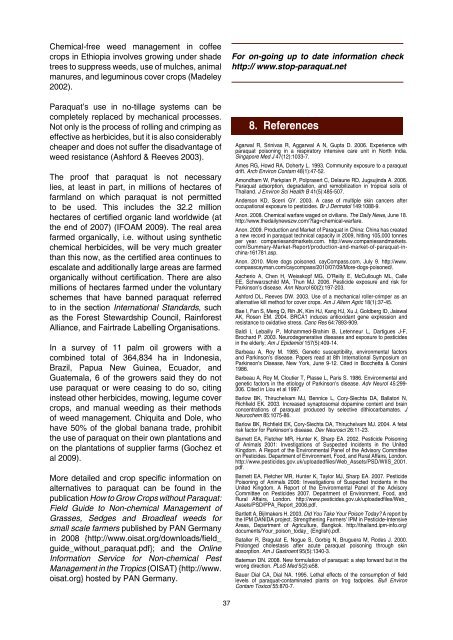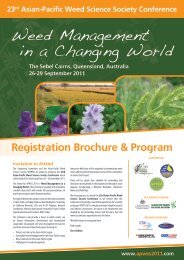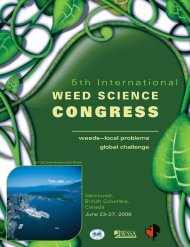PARAQUAT
PARAQUAT
PARAQUAT
You also want an ePaper? Increase the reach of your titles
YUMPU automatically turns print PDFs into web optimized ePapers that Google loves.
Chemical-free weed management in coffee<br />
crops in Ethiopia involves growing under shade<br />
trees to suppress weeds, use of mulches, animal<br />
manures, and leguminous cover crops (Madeley<br />
2002).<br />
Paraquat’s use in no-tillage systems can be<br />
completely replaced by mechanical processes.<br />
Not only is the process of rolling and crimping as<br />
effective as herbicides, but it is also considerably<br />
cheaper and does not suffer the disadvantage of<br />
weed resistance (Ashford & Reeves 2003).<br />
The proof that paraquat is not necessary<br />
lies, at least in part, in millions of hectares of<br />
farmland on which paraquat is not permitted<br />
to be used. This includes the 32.2 million<br />
hectares of certifi ed organic land worldwide (at<br />
the end of 2007) (IFOAM 2009). The real area<br />
farmed organically, i.e. without using synthetic<br />
chemical herbicides, will be very much greater<br />
than this now, as the certifi ed area continues to<br />
escalate and additionally large areas are farmed<br />
organically without certifi cation. There are also<br />
millions of hectares farmed under the voluntary<br />
schemes that have banned paraquat referred<br />
to in the section International Standards, such<br />
as the Forest Stewardship Council, Rainforest<br />
Alliance, and Fairtrade Labelling Organisations.<br />
In a survey of 11 palm oil growers with a<br />
combined total of 364,834 ha in Indonesia,<br />
Brazil, Papua New Guinea, Ecuador, and<br />
Guatemala, 6 of the growers said they do not<br />
use paraquat or were ceasing to do so, citing<br />
instead other herbicides, mowing, legume cover<br />
crops, and manual weeding as their methods<br />
of weed management. Chiquita and Dole, who<br />
have 50% of the global banana trade, prohibit<br />
the use of paraquat on their own plantations and<br />
on the plantations of supplier farms (Gochez et<br />
al 2009).<br />
More detailed and crop specific information on<br />
alternatives to paraquat can be found in the<br />
publication How to Grow Crops without Paraquat:<br />
Field Guide to Non-chemical Management of<br />
Grasses, Sedges and Broadleaf weeds for<br />
small scale farmers published by PAN Germany<br />
in 2008 {http://www.oisat.org/downloads/fi eld_<br />
guide_without_paraquat.pdf}; and the Online<br />
Information Service for Non-chemical Pest<br />
Management in the Tropics (OISAT) {http://www.<br />
oisat.org} hosted by PAN Germany.<br />
For on-going up to date information check<br />
http:// www.stop-paraquat.net<br />
8. References<br />
Agarwal R, Srinivas R, Aggarwal A N, Gupta D. 2006. Experience with<br />
paraquat poisoning in a respiratory intensive care unit in North India.<br />
Singapore Med J 47(12):1033-7.<br />
Ames RG, Howd RA, Doherty L. 1993. Community exposure to a paraquat<br />
drift. Arch Environ Contam 48(1):47-52.<br />
Amondham W, Parkpian P, Polprasert C, Delaune RD, Jugsujinda A. 2006.<br />
Paraquat adsorption, degradation, and remobilization in tropical soils of<br />
Thailand. J Environ Sci Health B 41(5):485-507.<br />
Anderson KD, Scerri GY. 2003. A case of multiple skin cancers after<br />
occupational exposure to pesticides. Br J Dermatol 149:1088-9.<br />
Anon. 2008. Chemical warfare waged on civilians. The Daily News, June 18.<br />
http://www.thedailynewszw.com/?tag=chemical-warfare.<br />
Anon. 2009. Production and Market of Paraquat in China: China has created<br />
a new record in paraquat technical capacity in 2009, hitting 105,000 tonnes<br />
per year. companiesandmarkets.com. http://www.companiesandmarkets.<br />
com/Summary-Market-Report/production-and-market-of-paraquat-inchina-161781.asp.<br />
Anon. 2010. More dogs poisoned. cayCompass.com, July 9. http://www.<br />
compasscayman.com/caycompass/2010/07/09/More-dogs-poisoned/.<br />
Ascherio A, Chen H, Weisskopf MG, O’Reilly E, McCullough ML, Calle<br />
EE, Schwarzschild MA, Thun MJ. 2006. Pesticide exposure and risk for<br />
Parkinson’s disease. Ann Neurol 60(2):197-203.<br />
Ashford DL, Reeves DW. 2003. Use of a mechanical roller-crimper as an<br />
alternative kill method for cover crops. Am J Altern Agric 18(1):37-45.<br />
Bae I, Fan S, Meng Q, Rih JK, Kim HJ, Kang HJ, Xu J, Goldberg ID, Jaiswal<br />
AK, Rosen EM. 2004. BRCA1 induces antioxidant gene expression and<br />
resistance to oxidative stress. Canc Res 64:7893-909.<br />
Baldi I, Lebailly P, Mohammed-Brahim B, Letenneur L, Dartigues J-F,<br />
Brochard P. 2003. Neurodegenerative diseases and exposure to pesticides<br />
in the elderly. Am J Epidemiol 157(5):409-14.<br />
Barbeau A, Roy M. 1985. Genetic susceptibility, environmental factors<br />
and Parkinson’s disease. Papers read at 8th International Symposium on<br />
Parkinson’s Disease, New York, June 9-12. Cited in Bocchetta & Corsini<br />
1986.<br />
Barbeau A, Roy M, Cloutier T, Plasse L, Paris S. 1986. Environmental and<br />
genetic factors in the etiology of Parkinson’s disease. Adv Neurol 45:299-<br />
306. Cited in Liou et al 1997.<br />
Barlow BK, Thiruchelvam MJ, Bennice L, Cory-Slechta DA, Ballatori N,<br />
Richfi eld EK. 2003. Increased synaptosomal dopamine content and brain<br />
concentrations of paraquat produced by selective dithiocarbamates. J<br />
Neurochem 85:1075-86.<br />
Barlow BK, Richfi eld EK, Cory-Slechta DA, Thiruchelvam MJ. 2004. A fetal<br />
risk factor for Parkinson’s disease. Dev Neurosci 26:11-23.<br />
Barnett EA, Fletcher MR, Hunter K, Sharp EA. 2002. Pesticide Poisoning<br />
of Animals 2001: Investigations of Suspected Incidents in the United<br />
Kingdom. A Report of the Environmental Panel of the Advisory Committee<br />
on Pesticides. Department of Environment, Food, and Rural Affairs, London.<br />
http://www.pesticides.gov.uk/uploadedfi les/Web_Assets/PSD/WIIS_2001.<br />
pdf.<br />
Barnett EA, Fletcher MR, Hunter K, Taylor MJ, Sharp EA. 2007. Pesticide<br />
Poisoning of Animals 2006: Investigations of Suspected Incidents in the<br />
United Kingdom. A Report of the Environmental Panel of the Advisory<br />
Committee on Pesticides 2007. Department of Environment, Food, and<br />
Rural Affairs, London. http://www.pesticides.gov.uk/uploadedfiles/Web_<br />
Assets/PSD/PPA_Report_2006.pdf.<br />
Bartlett A, Bijlmakers H. 2003. Did You Take Your Poison Today? A report by<br />
the IPM DANIDA project. Strengthening Farmers’ IPM in Pesticide-Intensive<br />
Areas, Department of Agriculture, Bangkok. http://thailand.ipm-info.org/<br />
documents/Your_poison_today_ (English).pdf.<br />
Bataller R, Bragulat E, Nogue S, Gorbig N, Bruguera M, Rodes J. 2000.<br />
Prolonged cholestasis after acute paraquat poisoning through skin<br />
absorption. Am J Gastroent 95(5):1340-3.<br />
Bateman DN. 2008. New formulation of paraquat: a step forward but in the<br />
wrong direction. PLoS Med 5(2):e58.<br />
Bauer Dial CA, Dial NA. 1995. Lethal effects of the consumption of fi eld<br />
levels of paraquat-contaminated plants on frog tadpoles. Bull Environ<br />
Contam Toxicol 55:870-7.<br />
37




